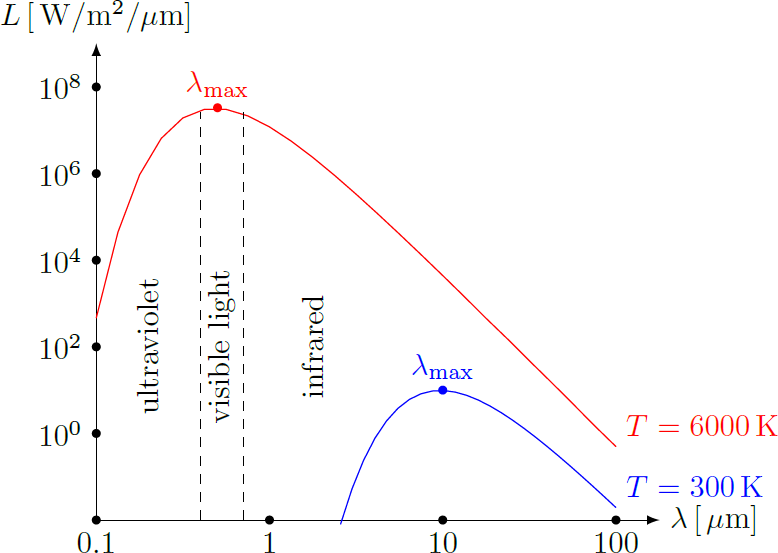Atmospheric physics 11: Thermal radiation

Due to their temperature, all bodies emit thermal radiation, which is electromagnetic radiation. This radiation is also often called black-body radiation, since the theory assumes a body, that is completely opaque and non-reflective. Depending on the temperature of the body, microwaves, infrared radiation, visible light, UV radiation or even X-ray radiation can be emitted to certain proportions. The maximum radiation occurs for a black body at a wavelength , which results from Wien's law: where denotes the abosolute temperature in Kelvin. The complete spectrum of thermal radiation resembles a bell curve with a maximum at , as shown in the diagram to the right (Planck's law). With increasing temperature, the maximum shifts to smaller wavelengths and higher frequencies. While the sun, with a surface temperature of around 6000 Kelvin, emits a major part of the radiation as visible light (), the radiation peaks at room temperature in the mid-infrared range ().
But not only the wavelength range, but also the total power of the heat radiation (area under the spectrum curve) depends on the temperature of the body. The total intensity of thermal radiation (power per surface area) follows the Stefan–Boltzmann law: where is the Stefan-Boltzmann constant and is the so-called emissivity. Emissivity represents the effectiveness with which a body releases thermal radiation. An ideal black body corresponds to the case , while a body, that does not absorb all incident radiation (a gray body), is characterized by an emissivity . Note, that due to the fourth power in the Stefan-Boltzmann law, a doubling of the temperature means a 16-fold increase in thermal radiation.
Easy Math Editor
This discussion board is a place to discuss our Daily Challenges and the math and science related to those challenges. Explanations are more than just a solution — they should explain the steps and thinking strategies that you used to obtain the solution. Comments should further the discussion of math and science.
When posting on Brilliant:
*italics*or_italics_**bold**or__bold__paragraph 1
paragraph 2
[example link](https://brilliant.org)> This is a quote# I indented these lines # 4 spaces, and now they show # up as a code block. print "hello world"\(...\)or\[...\]to ensure proper formatting.2 \times 32^{34}a_{i-1}\frac{2}{3}\sqrt{2}\sum_{i=1}^3\sin \theta\boxed{123}Comments
There are no comments in this discussion.